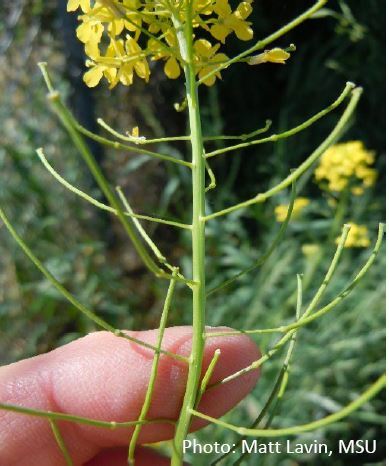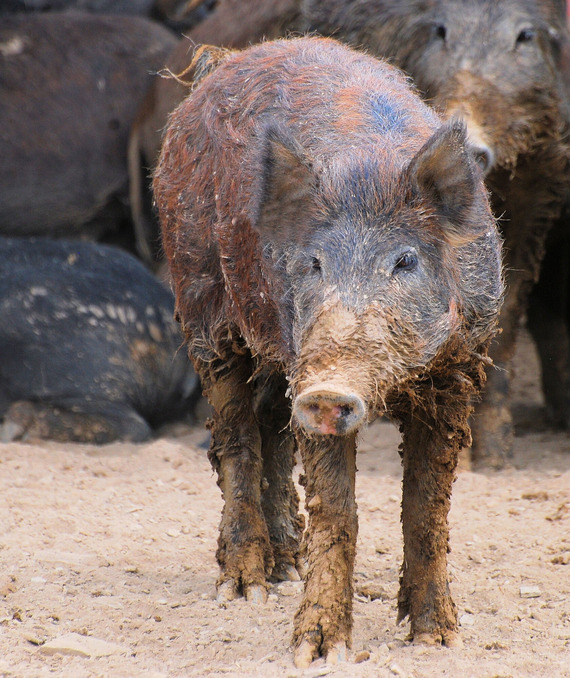
Tall Tumblemustard
Sisymbrium altissimum
Tall tumblemustard is an exotic species in the mustard family. This species grows throughout Montana, inhabiting disturbed soil of grasslands, agricultural fields, streambanks, and roadsides from low to mid elevations. Tall tumblemustard has been introduced widely in North America and is thought to have originated in Eurasia.
Read more from MSU Extension Continue reading...
|
News
Zebra Mussels Discovered in Lake Oahe South Dakota
Zebra mussels have been confirmed in the lower end of Lake Oahe in South Dakota, after the species was detected at both the East Shore and Cow Creek boat ramps during inspection done by South Dakota Game, Fish and Parks staff. Continue reading...
Invasive Mussels could Cost BC Economy $129M Annually if They Take Hold in Province
The Okanagan Basin Water Board is seeking the city's support in calling on senior governments for immediate action to prevent the introduction of invasive zebra and quagga mussels into B.C. waters.
"If senior governments fail to act, local governments and First Nations in B.C. will bear the brunt of managing and paying for the costs of invasive mussel mitigation," water board executive director Anna Warwick Sears says in a letter to council.
Concern is higher than usual as Idaho announced in September that quagga mussels had been found in the Snake River, a tributary to the Columbia River.
The location of the discovery at Twin Falls is less than an 11-hour drive from the B.C. border. Continue reading...
Signal Crayfish Confirmed in Minnesota
NOTE: Signal crayfish are native to portions of the Pacific Northwest including western Montana.
The Minnesota Department of Natural Resources has confirmed the presence of signal crayfish, an invasive non-native species, in Lake Winona, adjacent to Alexandria in Douglas County. This is the first confirmation of signal crayfish in Minnesota waters.
A commercial harvester contacted the DNR after trapping two signal crayfish in Lake Winona. Since the first catch, the harvester has found eight additional signal crayfish in Lake Winona. The DNR followed up with trapping in Lake Winona and in two adjacent connected lakes but did not capture additional signal crayfish. Continue reading...
Out-of-Control Invasive 'Super Pigs' Set to Cross US Border
Hordes of "super pigs" are running amok in Canada, and may soon spill across the border into the northern U.S.
These wild feral pigs, which roam Alberta, Saskatchewan and Manitoba in Canada, are predicted to be moving southwards into Minnesota, North Dakota and Montana.
What makes these pigs such a threat is that they are a result of crossbreeding between wild Eurasian boars and domestic swine. The animals combine the boar's environmental resistance and the pig's size and fertility to create a rapidly reproducing population that is very hard to eradicate. Continue reading...
 Photo: USDA
USDA Researchers Confirm Six Unique Strains of African Swine Fever Virus
Development suggests a lower number of vaccines to combat ASFV outbreaks.
The U.S. Department of Agriculture-Agricultural Research Service (USDA-ARS) announced that researchers have reclassified the number of African Swine Fever (ASF) virus strains from 25 to only six unique genotypes. This scientific innovation may help redefine how ASF researchers across the globe classify ASF virus (ASFV) isolates and may make it easier for scientists to develop vaccines that match the different strains circulating in ASF endemic areas across the globe.
"Previously, 25 different virus genotypes were identified across the globe," said senior ARS scientist Douglas Gladue. "Our research team recently re-evaluated all the publicly available virus DNA sequence and found that the majority of genotypes (genetic makeup) originally identified as novel were not correctly identified nor compared to already existing ASFV virus genotypes. Based on this analysis, there are actually fewer unique genotypes than the ASF research community believed, and that means that there is less diversity of ASFV affecting communities across the globe. This information is important as it may reduce the number of vaccines previously thought to be needed to protect against all ASFV genotypes." Continue reading...
Out with the Buckthorn and Honeysuckle, Make Way for the Oaks at McHenry County Conservation District in Illinois
"You couldn’t see the trees for the bushes when he started volunteering to clean up Stickney Run Conservation Area" site steward Pete Jackson said.
He started volunteering at the park, part of the McHenry County Conservation District, seven or eight years ago, shortly after moving to McHenry County and just before he retired, Jackson said.
Now, Jackson is at the park off State Park Road in McHenry three or four times a month, helping to clear out the invasive and non-native buckthorn and honeysuckle that have taken over parts of the park.
As site steward, Jackson directs volunteers and has assembled an email list to let them know when workdays are planned. Continue reading...
New Study Reveals Huge Potential for Future Waves of Invasive Species
Human trade and transport have led to the intentional and accidental introductions of non-native species outside of their natural range globally. These biological invasions can cause extinctions, cost trillions, and spread diseases. A study has investigated how many of these non-native species already exist worldwide and which species groups are particularly prone to become non-native. Continue reading...
FREE – Classical Weed Biological Control 101 Short Course
This asynchronous, professional short course covers the science, application, and regulation of classical weed biological control and features six presentations by professionals with real world experience managing invasive plants. Registration is free thanks to funding from the USDA Forest Service.
National Invasive Species Awareness Week:
- Feb 27 11:30 – 1:30 (MST): – Virtual
- Feb 28 - Washington DC
December 20, 2023: The Dilemma for Control of Invasive Species: Incorrect Terms Limit Our Capacity to Respond
January 17, 2024: Protecting Threatened and Endangered Species from Pesticides
|